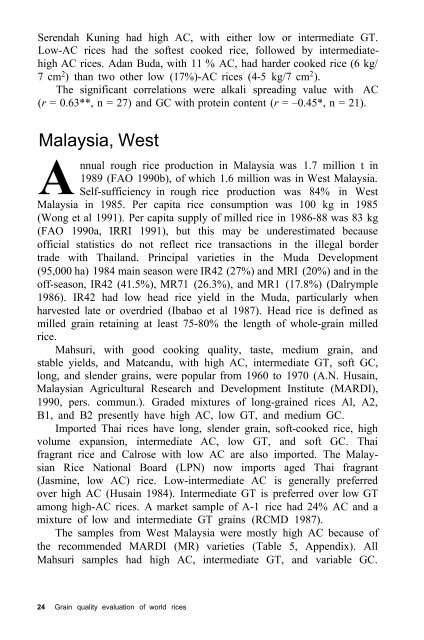Juliano et al. - 1993 - Grain Quality Evaluation of World Rices
Juliano et al. - 1993 - Grain Quality Evaluation of World Rices
Juliano et al. - 1993 - Grain Quality Evaluation of World Rices
Create successful ePaper yourself
Turn your PDF publications into a flip-book with our unique Google optimized e-Paper software.
Serendah Kuning had high AC, with either low or intermediate GT.<br />
Low-AC rices had the s<strong>of</strong>test cooked rice, followed by intermediatehigh<br />
AC rices. Adan Buda, with 11 % AC, had harder cooked rice (6 kg/<br />
7 cm 2 ) than two other low (17%)-AC rices (4-5 kg/7 cm 2 ).<br />
The significant correlations were <strong>al</strong>k<strong>al</strong>i spreading v<strong>al</strong>ue with AC<br />
(r = 0.63**, n = 27) and GC with protein content (r = –0.45*, n = 21).<br />
M<strong>al</strong>aysia, West<br />
A<br />
nnu<strong>al</strong><br />
rough rice production in M<strong>al</strong>aysia was 1.7 million t in<br />
1989 (FAO 1990b), <strong>of</strong> which 1.6 million was in West M<strong>al</strong>aysia.<br />
Self-sufficiency in rough rice production was 84% in West<br />
M<strong>al</strong>aysia in 1985. Per capita rice consumption was 100 kg in 1985<br />
(Wong <strong>et</strong> <strong>al</strong> 1991). Per capita supply <strong>of</strong> milled rice in 1986-88 was 83 kg<br />
(FAO 1990a, IRRI 1991), but this may be underestimated because<br />
<strong>of</strong>fici<strong>al</strong> statistics do not reflect rice transactions in the illeg<strong>al</strong> border<br />
trade with Thailand. Princip<strong>al</strong> vari<strong>et</strong>ies in the Muda Development<br />
(95,000 ha) 1984 main season were IR42 (27%) and MRI (20%) and in the<br />
<strong>of</strong>f-season, IR42 (41.5%), MR71 (26.3%), and MR1 (17.8%) (D<strong>al</strong>rymple<br />
1986). IR42 had low head rice yield in the Muda, particularly when<br />
harvested late or overdried (Ibabao <strong>et</strong> <strong>al</strong> 1987). Head rice is defined as<br />
milled grain r<strong>et</strong>aining at least 75-80% the length <strong>of</strong> whole-grain milled<br />
rice.<br />
Mahsuri, with good cooking qu<strong>al</strong>ity, taste, medium grain, and<br />
stable yields, and Matcandu, with high AC, intermediate GT, s<strong>of</strong>t GC,<br />
long, and slender grains, were popular from 1960 to 1970 (A.N. Husain,<br />
M<strong>al</strong>aysian Agricultur<strong>al</strong> Research and Development Institute (MARDI),<br />
1990, pers. commun.). Graded mixtures <strong>of</strong> long-grained rices Al, A2,<br />
B1, and B2 presently have high AC, low GT, and medium GC.<br />
Imported Thai rices have long, slender grain, s<strong>of</strong>t-cooked rice, high<br />
volume expansion, intermediate AC, low GT, and s<strong>of</strong>t GC. Thai<br />
fragrant rice and C<strong>al</strong>rose with low AC are <strong>al</strong>so imported. The M<strong>al</strong>aysian<br />
Rice Nation<strong>al</strong> Board (LPN) now imports aged Thai fragrant<br />
(Jasmine, low AC) rice. Low-intermediate AC is gener<strong>al</strong>ly preferred<br />
over high AC (Husain 1984). Intermediate GT is preferred over low GT<br />
among high-AC rices. A mark<strong>et</strong> sample <strong>of</strong> A-1 rice had 24% AC and a<br />
mixture <strong>of</strong> low and intermediate GT grains (RCMD 1987).<br />
The samples from West M<strong>al</strong>aysia were mostly high AC because <strong>of</strong><br />
the recommended MARDI (MR) vari<strong>et</strong>ies (Table 5, Appendix). All<br />
Mahsuri samples had high AC, intermediate GT, and variable GC.<br />
24 <strong>Grain</strong> qu<strong>al</strong>ity ev<strong>al</strong>uation <strong>of</strong> world rices

















